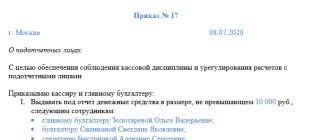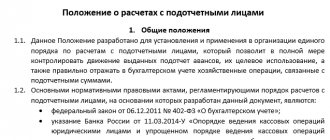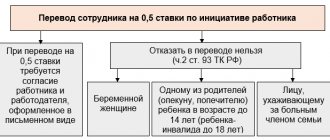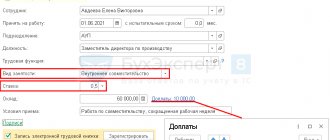At the beginning of 2012 and as of the date of publication of the journal, the Bank of Russia refinancing rate, or discount rate, was 8 percent*. It is an instrument for regulating the monetary system. With its help, the Bank of Russia influences interest rates on deposits and loans provided by credit institutions to legal entities and individuals. Organizational accountants also use the discount rate to calculate the following indicators:
- penalties for late fulfillment of tax payment obligations;
- material benefit received from savings on interest for a citizen’s use of borrowed (credit) funds received from organizations or individual entrepreneurs and expressed in rubles;
- the maximum amount of interest accrued on a debt obligation expressed in rubles and included in expenses (clause 1 of Article 269 of the Tax Code of the Russian Federation);
- the minimum amount of interest (monetary compensation) in case the employer violates the established deadline for payment of wages, vacation pay, dismissal payments and other payments due to the employee.
Penalties for late payment of taxes
Penalties for late fulfillment of tax payment obligations are determined as a percentage of the unpaid amount. In this case, the interest rate of penalties is taken equal to 1/300 of the refinancing rate of the Bank of Russia in force at that time (clause 4 of article 75 of the Tax Code of the Russian Federation).
Penalties, as a rule, are accrued for each calendar day of delay in fulfilling the obligation to pay tax, starting from the next day of payment, which is established by law.
The accrual of penalties stops on the day following the day of actual payment of tax arrears. Example 1
Norma LLC did not pay land tax in the amount of 6,000 rubles by the deadline of February 1, 2012. The organization repaid the specified debt only on March 30 of the same year. The refinancing rate of the Bank of Russia from February 2 to March 30 (58 days) was 8 percent (taken conditionally). Norma LLC calculated the amount of penalties in the amount of 92.8 rubles. (RUB 6,000 X 58 days X 8%: 300).
During the billing period, the discount rate may change, and more than once. The question arises: which of its values should be taken to determine penalties for late fulfillment of the obligation to pay tax in this case?
Here it should be borne in mind that when during the period for which penalties are accrued, the refinancing rate of the Bank of Russia changed both upward and downward, all its values for each period of validity are applied.
This is evidenced, for example, by resolutions of the FAS East Siberian District dated February 19, 2009 No. A19-9104/08-51-F02-493/2009, FAS Moscow District dated March 31, 2009 No. KA-A41/2507-09 . Let's look at what has been said with an example. Example 2
Akatsiya LLC did not pay the transport tax for 2011 in the amount of 10,000 rubles on time. The tax payment deadline is February 1, 2012. The organization paid off the tax debt in the following order:
- February 15 – 4000 rubles;
- March 2 – 6000 rub.
Thus, the amount of tax arrears was:
- from February 2 to February 14 (13 days) – 10,000 rubles;
- from February 15 to March 1 (17 days) – 6,000 rubles.
The refinancing rate had the following values (conditionally):
- from February 2 to February 10 (9 days) – 8%;
- from February 11 to February 20 (10 days) – 8.25%;
- from February 21 to February 29 (9 days) – 8.5%;
- from March 1 to 2 (2 days) – 8.25%.
Akatsiya LLC calculated the amount of penalties in the amount of 63.5 rubles. [(10,000 rubles X 9 days X 8%: 300) + (10,000 rubles X X 4 days X 8.25%: 300) + (6000 rubles X 6 days X 8.25%: 300) + (6000 rubles X 9 days X 8.5%: 300) + (6000 rubles X 2 days X X 8.25%: 300)].
Compensation for delayed wages
A decrease in the key rate to 6.00% will also entail changes in the amount of compensation for late wages.
Example
The amount of salary arrears is 10,000 rubles. The delay period is 10 days. During the delay period, a new key rate was in effect - 6.00%. To calculate compensation, wage arrears must be multiplied by 1/150 of the key rate and the number of days of delay. Accordingly, compensation for five days of delay will be 40 rubles. (RUB 10,000 × 6.00% / 150 × 10).
Material benefits from ruble loans
The income of an individual subject to personal income tax is, in particular, the material benefit received from savings on interest for the use of borrowed (credit) funds received from organizations or individual entrepreneurs and expressed in rubles. When a taxpayer receives income in the form of such a material benefit, the tax base is determined as the excess of the amount of interest for the use of borrowed (credit) funds, expressed in rubles, calculated on the basis of 2/3 of the current refinancing rate established by the Bank of Russia on the date the taxpayer actually received income, over the amount interest calculated based on the terms of the agreement. The basis is subparagraph 1 of paragraph 1, subparagraph 1 of paragraph 2 of Article 212 of the Tax Code.
Please note that taxable personal income tax income in the form of material benefits from savings on interest for the use of borrowed (credit) funds denominated in rubles arises for the borrower in cases where:
- the terms of the loan agreement (credit agreement) provide for the payment of interest at a rate equal to less than 2/3 of the refinancing rate of the Bank of Russia;
- the loan (credit) is interest-free.
Attention
If the loan agreement contains a condition on changing the interest rate, regardless of whether it has changed or not, when calculating expenses in the form of interest, the refinancing rate of the Central Bank of the Russian Federation, effective on the date of recognition of interest, is applied. This follows from paragraph 1 of Article 269 of the Tax Code.
Late tax refund
If the tax inspectorate returned the overpayment of taxes with a delay, it is obliged to pay interest to the company or individual entrepreneur at the refinancing rate (Article 78 of the Tax Code of the Russian Federation). As a general rule, they must transfer money to the current account within a month after they received an application for the return of the overpayment (clause 6 of Article 78 of the Tax Code of the Russian Federation). But tax authorities may not meet this deadline. Then you need to calculate interest taking into account the key rate.
Example
An organization filed an application for a refund of overpayment of tax in the amount of 140,000 rubles. However, the tax authorities returned the overpayment 8 days late. The accountant submitted an application to the Federal Tax Service for payment of interest for the delay in tax refund. The amount of interest was 184.11 rubles. (140,000 × 6.00% / 365 days × 8 days).
Rate used
When receiving income in the form of material benefits, the date of actual receipt of income is determined as the day the taxpayer pays interest on the borrowed (credit) funds received (subclause 3, clause 1, article 223 of the Tax Code of the Russian Federation). This means that when calculating the material benefit on ruble loans (credits), you should use the Bank of Russia refinancing rate valid on the day of actual payment of interest.
For information
The refinancing rate refers to the rate at which the Central Bank of Russia lends funds to credit institutions. It is clear that banks cannot lend to legal entities or individuals at a lower interest rate.
The refinancing rate of the Bank of Russia, established on the date of actual repayment of the loan amount, is used to calculate the amount of savings on interest on an interest-free loan. After all, the date of actual receipt of income in the form of material benefits from savings on interest for using an interest-free loan (credit) should be considered the date of return of the borrowed (credit) funds by the taxpayer. This is evidenced by letters of the Ministry of Finance of Russia dated July 25, 2011 No. 03-04-05/6-531, dated January 22, 2010 No. 03-04-06/6-3, dated July 17, 2009 No. 03-04 -06-01/175 and dated April 14, 2009 No. 03-04-06-01/89.
So, based on the above, for an interest-bearing ruble loan, the tax base (NB) can be determined by the tax agent using the formula:
NB = P2/3BR – Pdog , where
P2/3BR – the amount of interest based on a rate equal to 2/3 of the Bank of Russia refinancing rate in effect on the date of payment;
Pdog – the amount of interest payable according to the terms of the loan (credit) agreement.
The amount of interest payable under the terms of the loan (credit) agreement (Pdog) is determined by the formula:
Pdog = Сз X PSdog: KDg X KDpol , where
Сз – loan (credit) amount;
PSDog – the interest rate established in the loan (credit) agreement; KDg – the total number of calendar days in a year;
KDpol – the number of days of using borrowed (credit) funds.
To calculate the amount of interest based on a rate equal to 2/3 of the Bank of Russia refinancing rate in effect on the date of payment (PR2/3BR), the formula is used:
P2/3BR = Sz X PS2/3BR: KDg KDpol , where
PS2/3BR is an interest rate equal to 2/3 of the Bank of Russia refinancing rate in effect on the date of interest payment.
If a ruble loan is interest-free, then the tax agent calculates the tax base (TB) using the following formula:
NB = SZ X PS2/3CB: KDtot KDuser , where
SZ – loan (credit) amount;
PS2/3CB – interest rate equal to 2/3 of the Bank of Russia refinancing rate in effect on the date of repayment (partial repayment) of the loan (credit);
KDtot – the total number of calendar days in a year;
KDuse – the number of days of use of borrowed (credit) funds.
Example 3
Volna LLC provided manager P.P.
Karasev received a loan in the amount of 26,000 rubles. for two months at 3 percent per annum on February 1, 2012. According to the terms of the loan agreement, the employee returns 13,000 rubles towards the principal debt on the last day of each month. with the simultaneous payment of interest for the use of borrowed funds. In this case, the amount of accrued interest is withheld from his salary. The Bank of Russia has set a refinancing rate of 8 percent per annum. It does not change until the end of the contract. February 29, 2012 P.P. Karasev returned part of the loan in the amount of 13,000 rubles, and on the same day the accountant of Volna LLC withheld interest calculated for February in the amount of 59.67 rubles from his salary. (RUB 26,000 X 3%: 366 days X 28 days). The interest rate, calculated based on 2/3 of the current refinancing rate of the Bank of Russia, is equal to 5.333% (8% X 2: 3). This means that Volna LLC provided a loan to the employee at a rate of less than 2/3 of the current refinancing rate of the Bank of Russia (3% < 5.333%). Therefore, Karasev receives income in the form of material benefits from savings on interest, which is included in the tax base for personal income tax. The amount of interest calculated on the basis of 2/3 of the Bank of Russia refinancing rate in effect on the date of interest payment for February is equal to 106.08 rubles. (RUB 26,000 X 5.333%: 366 days X 28 days). The amount of material benefit from savings on interest in February amounted to 46.41 rubles. (106.08 – 59.67). On March 31, 2012, Karasev returned to Volna LLC the remaining part of the loan in the amount of 13,000 rubles. and paid interest for this month in the amount of 31.98 rubles. [(RUB 26,000 – RUB 13,000) X 3%: 366 days. X 30 days]. The employee again generates income in the form of material benefits from savings on interest. After all, the refinancing rate of the Bank of Russia did not change on this date. The amount of interest calculated for this month based on 2/3 of the Bank of Russia refinancing rate is equal to 56.83 rubles. [(RUB 26,000 – RUB 13,000) X 5.333% : : 366 days X 30 days]. Consequently, the amount of material benefit from saving on interest for March amounted to 24.85 rubles. (56.83 – 31.98). Example 4
CJSC “Two Oceans” on February 1, 2012 provided storekeeper L.B. Akulov received a loan of 30,000 rubles. for two months. According to the terms of the agreement, no later than the 1st day of each month, he must return 15,000 rubles monthly. principal debt (loan). The loan provided to Akulov is interest-free. From the beginning to the end of the loan agreement, the refinancing rate of the Bank of Russia was 8 percent. On February 29, 2012, Akulov repaid the first part of the loan in the amount of 15,000 rubles. At the same time, he had income in the form of material benefits from saving on interest. The interest rate, which is 2/3 of the current refinancing rate of the Bank of Russia, is equal to 5.333 percent (8% X 2: 3). Thus, the amount of income for the period from February 2 to February 29, 2012, which ZAO “Two Oceans” calculated on February 29, 2012, amounted to 122.40 rubles. (RUB 30,000 X 5.333%: 366 days X 28 days). The personal income tax calculated from the specified amount of income was withheld by the accountant of Two Oceans CJSC from Akulov’s salary for February 2012. The next part of the loan in the amount of 15,000 rubles. The storekeeper returned it on March 30, 2012. On this day, the organization calculated the income in the form of material benefits received by Akulov from savings on interest for the period from March 1 to March 30, 2012. It amounted (taking into account the loan amount repaid on February 29, 2012) to 65.57 rubles. [(RUB 30,000 – RUB 15,000) X 5.333%: 366 days. X 30 days]. CJSC “Two Oceans” withheld the personal income tax calculated from this income from Akulov’s salary for March 2012.
How a specific bet value is set
The value of the key rate directly depends on the current economic situation and the inflation rate. The rate is raised if the inflation indicator jumps and vice versa.
This is how it really happens. If the Central Bank lowers the discount rate, it becomes profitable for the population to take out loans because they become cheaper. After all, you won’t have to overpay for borrowed money and you can solve your financial problems. Against this background, consumer demand increases - people begin to purchase a lot of different goods. This also applies to enterprises that will only benefit from investing extra money in their turnover. This arrangement allows you to increase production and make more profits.
Observing such popular activity, sellers begin to inflate prices for goods. And this leads to increased inflation - depreciation of money. Accordingly, the well-being of Russians is falling sharply, which causes discontent among them. This is a clear threat for the state, as it is fraught with popular riots.
Therefore, the Central Bank percentage acts as a kind of control device that stabilizes the inflation rate
. To reduce inflation, the central rate is raised. Then loans become more expensive and demand for them falls, as people stop spending money thoughtlessly. This leads to a reduction in the cost of goods.
Interest limit
In the absence of debt obligations issued in the same quarter on comparable terms, as well as at the choice of the taxpayer, the maximum amount of interest recognized as an expense is accepted from January 1, 2011 to December 31, 2012 inclusive, equal to the interest rate established by agreement of the parties. At the same time, it should not exceed the refinancing rate of the Bank of Russia, increased by 1.8 times (clause 1.1 of Article 269 of the Tax Code of the Russian Federation). This applies to expenses in the form of interest on debt obligations incurred from January 1, 2010.
The mentioned rate should be understood as:
- in relation to debt obligations that do not contain a condition on changing the interest rate throughout the entire term of the debt obligation,
- the Bank of Russia refinancing rate in effect on the date of raising funds;
- in relation to other debt obligations - the refinancing rate of the Bank of Russia, effective on the date of recognition of expenses in the form of interest.
For loan agreements and other similar agreements, the duration of which falls on more than one reporting period, for the purpose of calculating income tax, the expense is recognized as incurred and is included in the appropriate expenses at the end of the month of the corresponding reporting period. In the event of termination of the agreement (repayment of the debt obligation) before the expiration of the reporting period, the expense is recognized as incurred and is included in the corresponding expenses on the date of termination of the agreement (repayment of the debt obligation). This is stated in paragraph 8 of Article 272 of the Tax Code.
The Ministry of Finance pays attention
The agreement may provide for the payment of interest or the repayment of an interest-free loan at any frequency. And if the interest-free loan agreement provides for monthly repayment of the loan, income in the form of material benefits will arise on each date of repayment of the borrowed funds, that is, monthly. The Russian Ministry of Finance drew attention to this in a letter dated July 25, 2011 No. 03-04-05/6-531.
Let's say that a credit agreement (loan agreement) contains a condition on changing the refinancing rate of the Bank of Russia for using a credit (loan).
Then the maximum amount of interest for the use of borrowed funds must be calculated monthly based on the discount rate in effect on the last day of the calendar month. And if the debt obligation is repaid before the end of the reporting period - on the date of repayment of the borrowed funds. Moreover, changes in the refinancing rate of the Bank of Russia during the month are not taken into account when determining the amount of interest. Example 5
LLC Riturnel received a loan from the bank on February 1, 2012 under a loan agreement containing a condition on changing the interest rate during the entire term of the debt obligation. On February 1, 2012, the Bank of Russia refinancing rate was 8 percent, and from the 20th it was reduced to 7.75 percent. Riturnel LLC will calculate the amount of interest recognized in tax accounting for February based on a discount rate of 7.75 percent.
If the credit agreement (loan agreement) does not contain a condition on changing the interest rate for using the credit (loan), then the maximum amount of interest expenses is determined monthly based on the discount rate in effect on the date of receipt of credit (borrowed) funds.
Example 6
Arabesk LLC received a loan in the amount of 160,000 rubles on February 1, 2012. at 18 percent per annum. The loan agreement does not contain a condition on changing the interest rate for using the loan. The organization repaid the loan on time - March 20 of the same year. The refinancing rate of the Bank of Russia, in effect on the date of raising funds, that is, on February 1, 2012, is 8 percent. This means the marginal interest rate will be 14.4 percent (8% X 1.8). Arabesk LLC paid 2,281.97 rubles for the use of borrowed funds in February. (RUB 160,000 X 18%: 366 days X 29 days). However, for profit tax purposes, the organization took into account interest expenses in the amount of 1,825.57 rubles at the end of February. (RUB 160,000 X 14.4%: 366 days X 29 days). For the use of borrowed funds from March 1 to March 20, 2012, Arabesk LLC paid 1,573.77 rubles. (RUB 160,000 X 18%: 366 days X 20 days). However, for profit tax purposes, the organization took into account the interest expense in the amount of RUB 1,259.02 on the date of repayment of the loan funds. (RUB 160,000 X 14.4 5%: 366 days X 20 days).
What is the difference between the refinancing rate and the key rate?
The refinancing rate and the key rate are different indicators, although they are similar in some respects. Both of them arose in Russia due to the need to regulate credit relations between the Central Bank of the Russian Federation (CBRF) and ordinary commercial banks, but at different times:
- from 01/01/1992 - refinancing rate (telegram of the Central Bank of the Russian Federation dated 12/29/1991 No. 216-91);
- from 09/13/2013 - key rate (information from the Bank of Russia dated 09/13/2013).
Moreover, the introduction of the second rate excluded the use of the first in relations between banks. Why was the new indicator introduced, and how does the key rate differ from the refinancing rate?
The emergence of a new rate is due to economic reasons, the main of which are the need for a flexible response to changes in the financial situation in the country and the ability to influence inflation processes through this indicator.
The differences between the refinancing rate and the key rate lie primarily in the period of their validity:
- The first value evaluates the value of the annual percentage at which the Central Bank of the Russian Federation gave loans to commercial banks. It could change more often than once a year, but it could also remain unchanged for several years.
- The second rate is more dynamic, characterizing short-term (with a validity period of one week) credit relationships, which, along with loans issued by the Central Bank of the Russian Federation to banks, also includes the reverse process - deposits of commercial banks with the Central Bank of the Russian Federation. This figure changes 5–6 times a year.
See how the refinancing rate has changed in recent years here.
Due to more frequent changes in value, the new rate can actually influence the volume of funds coming into circulation from banks and, accordingly, used by consumers.
How the decision to change is made
Changing the key rate is the main instrument of the Central Bank’s monetary policy. Monetary policy is also called monetary policy. With its help, the Central Bank creates conditions for economic development.
Monetary policy itself does not develop or slow down the country's economy , but it does affect demand. If demand increases, labor productivity increases and technology develops. If demand decreases, labor productivity decreases and there is not enough money for technology. Monetary policy can be expansionary, contractionary or neutral.
Expansionary monetary policy is used if the economy slows and inflation is below target. During the stimulus policy, the Central Bank lowers the key rate so that inflation rises and the economy revives.
Contractionary monetary policy is applied if the economy is “overheated” and inflation is above the target level . In this case, the Central Bank raises the key rate to reduce inflation.
With a neutral policy, the key rate is kept for a long time at the level that the Central Bank considers most suitable for the economy. The rate itself does not change so that the economy remains in equilibrium.
The Central Bank makes decisions on changing the key rate based on the macroeconomic forecast and takes into account many factors: changes in taxes and the economy, the situation on world markets, statistical data. The change in the key rate affects the economy gradually over several quarters.
The Central Bank publishes monetary policy reports on its website to explain why it is changing the key rate and what further actions it will take.
Its meetings are scheduled for all 12 months. That is, the schedule for 2021 has been developed in advance. You could see it above.
It is important to note that meetings of the Board of Directors do not always take place according to schedule. They may be unplanned.
In particular, such an exceptional case was recorded in 2014. When the key rate was urgently raised by 6.5 percentage points.
After this, a gradual decline has been observed since 2015. The regulator reduced it without sudden jerks. Mostly by 0.25-0.5%. Although with a slight fluctuation at the end of 2022, the downward trend in rates continued through 2022.







